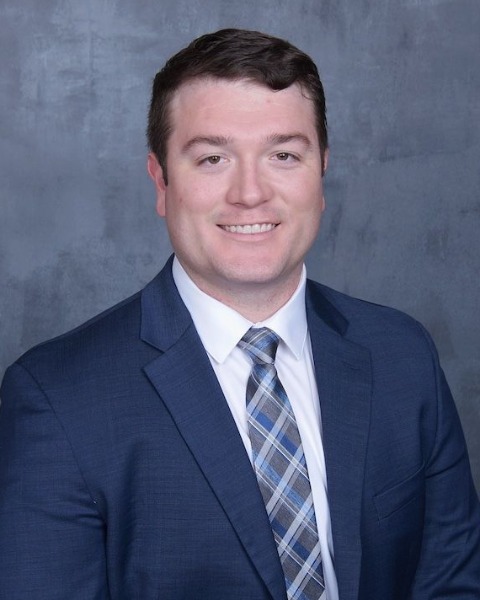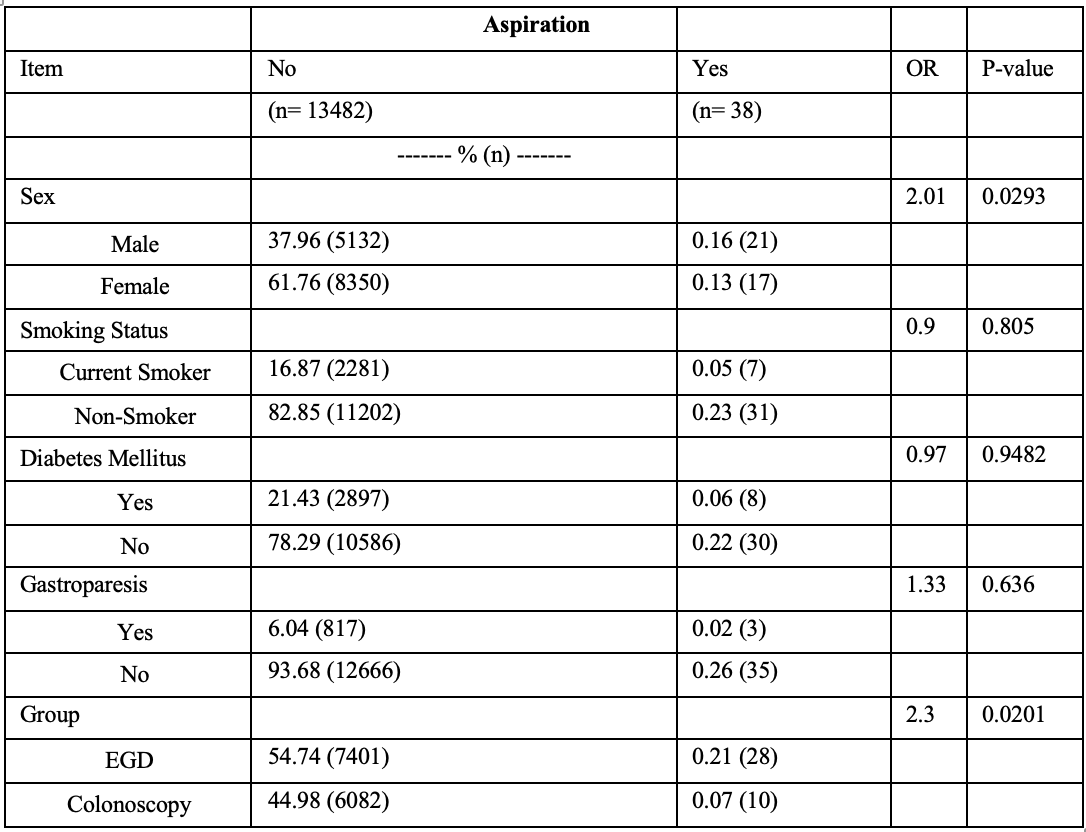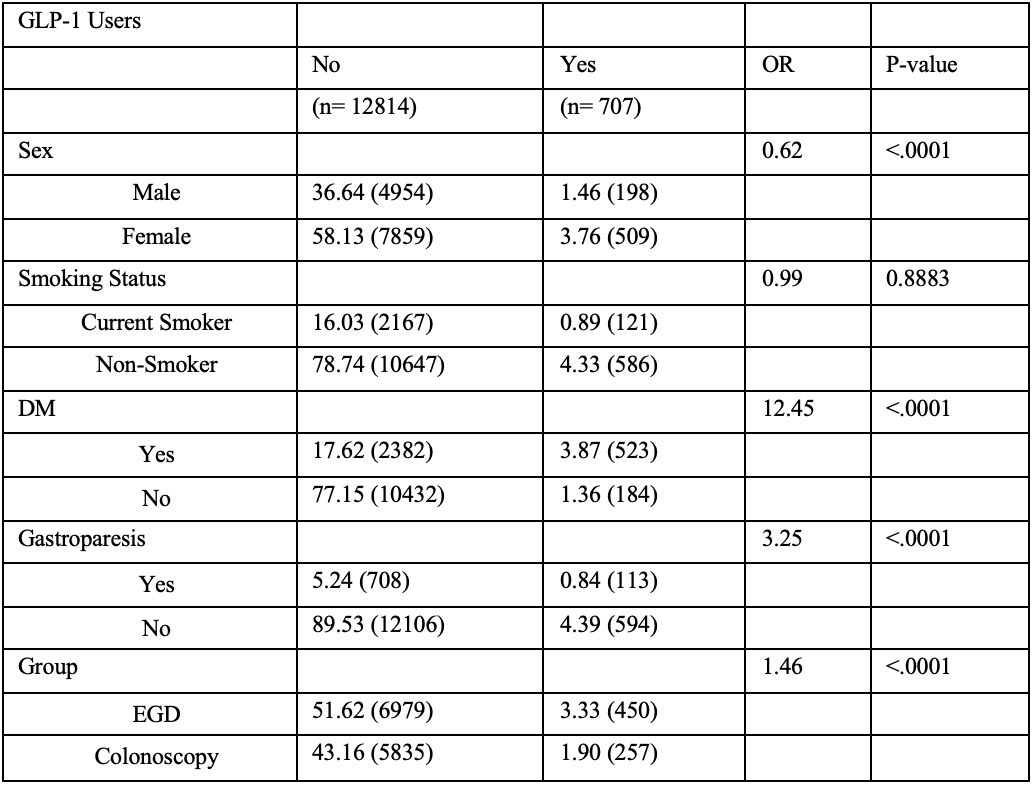Monday Poster Session
Category: General Endoscopy
P2981 - Comparison of Aspiration Risk in Patients Undergoing Upper Endoscopy vs Colonoscopy While on GLP-1 Agonist Therapy
Monday, October 27, 2025
10:30 AM - 4:00 PM PDT
Location: Exhibit Hall

Robert Molina, MD, MPH
Baylor Scott & White Medical Center
Temple, TX
Presenting Author(s)
Robert Molina, MD, MPH1, Maryana Stryelkina, DO1, Janice Thomas, MD1, Anupama Ancha, MD1, Justin Bejcek, MS2, Ian Fladie, DO1, Michael Mullarkey, MD1, Christopher Johnson, MD, PhD1
1Baylor Scott & White Medical Center, Temple, TX; 2Edward Via College of Osteopathic Medicine, Monroe, LA
Introduction: GLP-1RAs are increasingly used for Type 2 Diabetes Mellitus and weight management, but their known effect of delaying gastric emptying has raised concerns about increased aspiration risk during endoscopic procedures. While the risk of aspiration during upper endoscopy is recognized, data remains limited and conflicting—particularly regarding GLP-1RA users and colonoscopy. This study aimed to evaluate the risk of aspiration in patients undergoing esophagogastroduodenoscopy otherwise known as EGD versus colonoscopy while on GLP-1RA therapy.
Methods: We conducted a retrospective cohort study using electronic health records from the Baylor Scott & White Medical Center Temple hospital-based endoscopy center between July 31, 2017, and July 31, 2024. Adult patients aged 18–70 undergoing EGD or colonoscopy were included and stratified by GLP-1RA use. The primary outcome was aspiration-related events identified via ICD-10 codes within 30 days of the procedure. Chi-square tests and logistic regression were used to compare patient characteristics and assess the association between procedure type, GLP-1RA use, and aspiration risk.
Results: Out of 13,523 patients (7,431 EGD; 6,092 colonoscopy), 713 (5.3%) were GLP-1RA users. Aspiration events were more common during EGD than colonoscopy (OR = 2.30, P = 0.0201). Notably, no aspiration events occurred among GLP-1RA users. Male sex was associated with higher aspiration risk (OR = 2.01, P = 0.0293). GLP-1RA users had significantly higher BMI and were more likely to have diabetes and gastroparesis. However, GLP-1RA use was not independently associated with increased aspiration risk
Discussion: This large retrospective study demonstrates that aspiration risk is significantly higher in patients undergoing upper endoscopy compared to colonoscopy. Importantly, GLP-1RA therapy was not associated with increased aspiration risk during either procedure. These findings suggest that while procedure type influences aspiration risk, GLP-1RAs may not necessitate withholding prior to endoscopy in otherwise low-risk patients. Further prospective studies are warranted to refine risk stratification and optimize peri-procedural management in this growing patient population.

Figure: Table 1: Association between patient characteristics and event of aspiration.

Figure: Table 2: Association between patient characteristics among GLP-1 users.
Disclosures:
Robert Molina indicated no relevant financial relationships.
Maryana Stryelkina indicated no relevant financial relationships.
Janice Thomas indicated no relevant financial relationships.
Anupama Ancha indicated no relevant financial relationships.
Justin Bejcek indicated no relevant financial relationships.
Ian Fladie indicated no relevant financial relationships.
Michael Mullarkey indicated no relevant financial relationships.
Christopher Johnson indicated no relevant financial relationships.
Robert Molina, MD, MPH1, Maryana Stryelkina, DO1, Janice Thomas, MD1, Anupama Ancha, MD1, Justin Bejcek, MS2, Ian Fladie, DO1, Michael Mullarkey, MD1, Christopher Johnson, MD, PhD1. P2981 - Comparison of Aspiration Risk in Patients Undergoing Upper Endoscopy vs Colonoscopy While on GLP-1 Agonist Therapy, ACG 2025 Annual Scientific Meeting Abstracts. Phoenix, AZ: American College of Gastroenterology.
1Baylor Scott & White Medical Center, Temple, TX; 2Edward Via College of Osteopathic Medicine, Monroe, LA
Introduction: GLP-1RAs are increasingly used for Type 2 Diabetes Mellitus and weight management, but their known effect of delaying gastric emptying has raised concerns about increased aspiration risk during endoscopic procedures. While the risk of aspiration during upper endoscopy is recognized, data remains limited and conflicting—particularly regarding GLP-1RA users and colonoscopy. This study aimed to evaluate the risk of aspiration in patients undergoing esophagogastroduodenoscopy otherwise known as EGD versus colonoscopy while on GLP-1RA therapy.
Methods: We conducted a retrospective cohort study using electronic health records from the Baylor Scott & White Medical Center Temple hospital-based endoscopy center between July 31, 2017, and July 31, 2024. Adult patients aged 18–70 undergoing EGD or colonoscopy were included and stratified by GLP-1RA use. The primary outcome was aspiration-related events identified via ICD-10 codes within 30 days of the procedure. Chi-square tests and logistic regression were used to compare patient characteristics and assess the association between procedure type, GLP-1RA use, and aspiration risk.
Results: Out of 13,523 patients (7,431 EGD; 6,092 colonoscopy), 713 (5.3%) were GLP-1RA users. Aspiration events were more common during EGD than colonoscopy (OR = 2.30, P = 0.0201). Notably, no aspiration events occurred among GLP-1RA users. Male sex was associated with higher aspiration risk (OR = 2.01, P = 0.0293). GLP-1RA users had significantly higher BMI and were more likely to have diabetes and gastroparesis. However, GLP-1RA use was not independently associated with increased aspiration risk
Discussion: This large retrospective study demonstrates that aspiration risk is significantly higher in patients undergoing upper endoscopy compared to colonoscopy. Importantly, GLP-1RA therapy was not associated with increased aspiration risk during either procedure. These findings suggest that while procedure type influences aspiration risk, GLP-1RAs may not necessitate withholding prior to endoscopy in otherwise low-risk patients. Further prospective studies are warranted to refine risk stratification and optimize peri-procedural management in this growing patient population.

Figure: Table 1: Association between patient characteristics and event of aspiration.

Figure: Table 2: Association between patient characteristics among GLP-1 users.
Disclosures:
Robert Molina indicated no relevant financial relationships.
Maryana Stryelkina indicated no relevant financial relationships.
Janice Thomas indicated no relevant financial relationships.
Anupama Ancha indicated no relevant financial relationships.
Justin Bejcek indicated no relevant financial relationships.
Ian Fladie indicated no relevant financial relationships.
Michael Mullarkey indicated no relevant financial relationships.
Christopher Johnson indicated no relevant financial relationships.
Robert Molina, MD, MPH1, Maryana Stryelkina, DO1, Janice Thomas, MD1, Anupama Ancha, MD1, Justin Bejcek, MS2, Ian Fladie, DO1, Michael Mullarkey, MD1, Christopher Johnson, MD, PhD1. P2981 - Comparison of Aspiration Risk in Patients Undergoing Upper Endoscopy vs Colonoscopy While on GLP-1 Agonist Therapy, ACG 2025 Annual Scientific Meeting Abstracts. Phoenix, AZ: American College of Gastroenterology.
